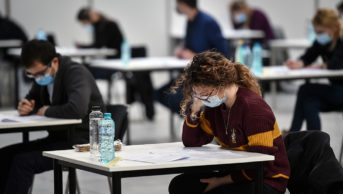
Shutterstock.com
Black African trainee pharmacists had the lowest pass rates in the General Pharmaceutical Council’s (GPhC) summer preregistration exam, despite attempts by the pharmacy regulator to discover why this ethnic group has historically performed poorly in the assessment.
According to figures from the GPhC, Black African students achieved a pass rate of 66.2%, the lowest of all the listed ethnicities. The second lowest pass rate was seen among Pakistani students, who achieved a pass rate of 71.6% (see table).
Meanwhile, White British students achieved the highest pass rate of 92.5%, followed by Chinese/Chinese British students, who achieved a pass rate of 89.5%.
The results are comparable with the 2017 summer preregistration assessment when Black African candidates again had the lowest pass rate of 65.6%, while White British students had the highest pass rate, at 93.6%.
In 2016, the GPhC carried out an investigation into why Black African trainee pharmacists performed less well in the registration assessments, with results suggesting that they could be more likely to struggle because many are also mature or overseas students. The research also showed that some Black African candidates experience bias and prejudice.
In July 2018, the GPhC said it would rewrite standards to ensure “equality of opportunity” for all preregistration pharmacists. It also said it would require pharmacy schools to be more “proactive” on equality and diversity.
The GPhC’s breakdown of the preregistration assessment also showed pass rates by pharmacy school (see table). The school with the lowest pass rate was the University of Central Lancashire, which had a pass rate of 56.8%. The highest pass rate was achieved by students from the University College London, which had a pass rate of 93.6%.
In response to the low pass rate, a spokesperson for the University of Central Lancashire said: “Preparing our students for professional practice as pharmacists is of the utmost importance to us.”
“We will be contacting the General Pharmaceutical Council to establish the validity of these results as they have not yet been officially shared with us. We are therefore unable to comment further at this time.”
In November 2017, the GPhC said it planned to meet with pharmacy schools to discuss poor performance by preregistration students in that summer’s exams.
In the council papers, the GPhC’s Board of Assessors defended the preregistration assessment despite hundreds of students saying the June 2018 exam was “complex”, “ambiguous” and “misleading”.
In a report on the exam, published by the British Pharmaceutical Students’ Association (BPSA), compiling feedback from 266 of the 2,942 candidates who sat the assessment, several recommendations were made. These included ensuring that resources available to students revising for the assessment were better aligned to the actual paper and that questions be distributed in such a way to allow candidates sufficient time to complete the paper.
After considering the BPSA report at its Board of Assessors meeting on 19 July 2018, the GPhC responded by highlighting that learning points were added annually to the resources available on its website and that the Registration Assessment Framework was also refreshed each year to ensure it reflects contemporary practice.
“The sample questions and questions for live papers are written by the same people and many of the sample questions have been used previously in live papers. For these reasons, the board is confident that the alignment between resources and live papers is good,” said the GPhC’s response.
It also said that the board had no evidence to suggest that there was insufficient time for candidates to complete the papers and that the questions were varied in terms of the length of time required to answer and overall difficulty.
The BPSA said it was aware of the comments of the Board of Assessors regarding the Registration Assessment Feedback presented to the GPhC by the BPSA and would formulate a response to be published on the BPSA website, in due course.
| Table 1: First attempt at the June 2018 registration assessment by ethnicity (≥ 20 candidates in a category) | ||||
|---|---|---|---|---|
| Source: GPhC. The following categories have not been reported because they contain <20 candidates: Black-Caribbean, Black-Other, Other Mixed, White-Irish, White and Black African, White and Black Caribbean. In addition, ‘Not supplied’ and ‘NULL’ have not been reported. | ||||
Average % mark | ||||
Ethnicity | Number of candidates | % pass rate | Part 1 | Part 2 |
Asian — Other | 177 | 73.4 | 76.2 | 74.4 |
Bangladeshi | 81 | 74.1 | 76.5 | 74.6 |
Black African | 219 | 66.2 | 70.6 | 72.2 |
Chinese / Chinese British | 229 | 89.5 | 84.7 | 78 |
Indian | 466 | 82.2 | 78.8 | 76.3 |
Other ethnic group | 83 | 74.7 | 77.1 | 75.3 |
Pakistani | 408 | 71.6 | 72.8 | 72.7 |
White British | 679 | 92.5 | 85.2 | 81.1 |
White and Asian | 24 | 83.3 | 80.3 | 76.1 |
White — Other | 73 | 79.5 | 77.9 | |
| Table 2: First attempt at the June 2018 registration assessment by school of pharmacy attended (MPharm degree) | ||||
|---|---|---|---|---|
| Source: GPhC. *Data have not been presented (1) for OSPAP providers, (2) for The Queen’s University, Belfast and University of Ulster (most of whose graduates sit the PSNI’s Registration Examination in Northern Ireland) and (3) the five-year integrated degrees at the University of East Anglia and University of Nottingham, because in all cases candidate numbers are <20. | ||||
Average % mark | ||||
School of Pharmacy* | Number of candidates | % pass rate | Part 1 | Part 2 |
Aston University | 118 | 89.8 | 81.1 | 77.8 |
University of Bath | 103 | 93.2 | 85.8 | 81.8 |
University of Birmingham | 55 | 83.6 | 79.6 | 77.0 |
University of Bradford (four-year continuous degree) | 69 | 73.9 | 73.2 | 73.4 |
University of Bradford (five-year sandwich degree) | 75 | 78.7 | 75.6 | 77.0 |
University of Brighton | 64 | 70.3 | 75.3 | 73.3 |
Cardiff University | 103 | 92.2 | 85.0 | 81.5 |
University of Central Lancashire | 95 | 56.8 | 68.9 | 69.2 |
De Montfort University | 113 | 75.2 | 75.0 | 72.8 |
University of Durham | 29 | 82.8 | 77.2 | 78.7 |
University of East Anglia | 96 | 86.5 | 83.8 | 78.6 |
University of Hertfordshire | 78 | 73.1 | 73.4 | 73.7 |
University of Huddersfield | 68 | 77.9 | 78.8 | 76.3 |
Keele University | 70 | 75.7 | 79.5 | 75.6 |
King’s College London | 88 | 90.9 | 83.0 | 78.0 |
Kingston University | 101 | 65.4 | 70.4 | 71.4 |
Liverpool John Moores University | 130 | 78.5 | 79.3 | 76.6 |
University of Manchester | 102 | 85.3 | 80.3 | 78.5 |
Medway School of Pharmacy (universities of Greenwich and Kent) | 98 | 87.8 | 79.3 | 76.9 |
University of Nottingham | 160 | 90.6 | 85.3 | 79.7 |
University of Portsmouth | 104 | 72.1 | 74.9 | 74.4 |
University of Reading | 101 | 74.3 | 77.0 | 74.2 |
The Robert Gordon University | 89 | 76.4 | 79.6 | 74.9 |
University of Strathclyde | 133 | 90.2 | 82.6 | 78.6 |
University of Sunderland | 101 | 89.1 | 80.8 | 82.5 |
University College London | 140 | 93.6 | 84.8 | 80.5 |
University of Wolverhampton | 67 | 65.7 | 70.1 | 69.9 |


